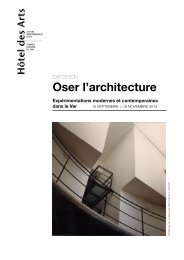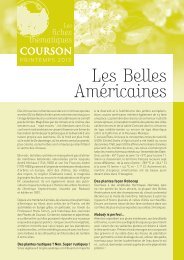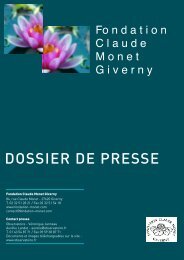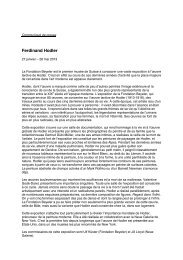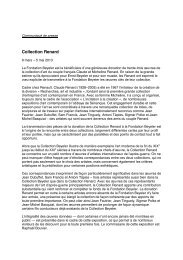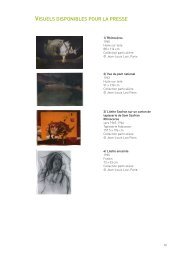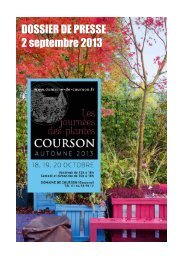POETRY, LOVE AND LIBERTY - Observatoire
POETRY, LOVE AND LIBERTY - Observatoire
POETRY, LOVE AND LIBERTY - Observatoire
You also want an ePaper? Increase the reach of your titles
YUMPU automatically turns print PDFs into web optimized ePapers that Google loves.
www.dynamic19.com<br />
Practical Information<br />
Palais Lumière Evian (quai Albert-Besson)<br />
Open every day from 10 am to 7 pm (from 2 pm to 7 pm on Mondays)<br />
Open Monday 1 April (Easter), Wednesday 1 May, Wednesday 8 May, Thursday 9 May (Ascension<br />
Day) and Monday 20 May(Pentecost).<br />
Tel.: +33 (0) 4 50 83 15 90 www.ville-evian.fr<br />
Curators: the Town of Saint-Denis, the Museum of Art and History, Sylvie Gonzalez,<br />
the Chief Curator of Heritage and Director.<br />
• General public<br />
- Full price: € 10.<br />
- Tours with audio-guides (French and English): € 4 plus<br />
the entrance fee;<br />
- Individual guided tours every day at 2.30 pm: € 4 plus<br />
the entrance fee.<br />
Themed tours (see the details in: “Beyond the exhibition”).<br />
• Young people/families<br />
- Free for children under 10;<br />
- Reduced price: € 8 for young people aged 10 to 16,<br />
students and large families;<br />
- Guided tours for families: discovery trail for children<br />
under 10 accompanied by their parents, every Wednesday<br />
at 4 pm.<br />
- “the Palais Lumière game”: a booklet guiding visitors<br />
round the exhibition playfully, available at the welcome<br />
desk.<br />
- Educational workshops (see the details in: “Beyond the<br />
exhibition”).<br />
Groups<br />
- Reduced price: € 8 (for groups of at least 10 people);<br />
- Guided tours booked in advance: + 33 (0) 4 50 83 10 19/<br />
courrier@ville-evian.fr, € 55 per group of 10 to 25 people,<br />
plus the entrance fee.<br />
At the Palais Lumière<br />
• 15 June - 22 September<br />
Legends of the Seas<br />
The art of travel on board liners<br />
ENTRANCE FEES<br />
Coming up in 2013<br />
Pupils/teachers<br />
- Free for school groups;<br />
- Guided tours booked in advance: +33 (0) 4 50 83 10 19/<br />
courrier@ville-evian.fr, € 55 per group of 10 to 25 people;<br />
- Teaching materials are available online at www.villeevian.fr<br />
Concessions (upon presentation of written proof)<br />
- Free for members of UDOTSI, Léman sans frontière<br />
cardholders and journalists;<br />
- Reduced price: € 8 for job-seekers, disabled visitors,<br />
C.E. or C.N.A.S. cardholders, associated hotels and holiday<br />
accommodation groups, media library and swimming<br />
pool members<br />
- 50% off entry price on presentation of a “Ville d’Evian”<br />
family card (full or reduced price);<br />
- Your ticket offers a 30% discount on entry to exhibitions<br />
being held at the Pierre Gianadda Foundation in Martigny.<br />
• Exhibition catalogue on sale at the welcome desk: € 35<br />
Box office at the entrance of the exhibition.<br />
Tickets on sale in the FNAC sales outlets and on<br />
www.fnac.com<br />
Discover the Palais Lumière Evian on<br />
At the Pierre Gianadda Foundation in Martigny<br />
• 28 June - 24 November<br />
Modigliani and the School of Paris, in partnership with<br />
the Pompidou Centre<br />
Fernand Léger, Paul Éluard, 1947, courtesy of the Museum of Art and History, Saint-Denis. Photograph: Irène Andréani © ADAGP, Paris 2012.<br />
Sunday 3 February<br />
• Concert by the professors of Evian School of<br />
Music, in association with the exhibition.<br />
- “Two songs” of Francis Poulenc on poems by<br />
Paul Eluard, voice and piano;<br />
- “Caprilena” by Jacques Ibert, for solo violin;<br />
- “Scaramouche” by Darius Milhaud, for saxophone<br />
and piano;<br />
- “Allegro Appassionato” by Camille Saint-Saëns<br />
for cello and piano;<br />
- “Gymnopedie” by Erik Satie for piano;<br />
- “Sonata for oboe and piano” by Camille<br />
Saint-Saëns.<br />
In the Auditorium of the Palais Lumière. 6.30 pm. Free<br />
entrance.<br />
Friday 15 February<br />
• “Liberty of the Ages” concert/show by piano<br />
soloist Vittorio Forte. Pieces include<br />
- F. Couperin’s “Pieces for Harpsichord”,<br />
- F. Chopin’s “Mazurkas”,<br />
- G. Martucci “Fantasy on “La Forca del destino””<br />
- G. Gershwin’s “Songs” & “Rhapsody in Blue”.<br />
At the Palais Lumière. 8 pm (one hour without an interval).<br />
€ 15 / € 13 (reduced price) including a visit to the exhibition.<br />
Box office at the entrance of the exhibition.<br />
• Themed tours<br />
- Friday 8*, Saturday 9 and Sunday 10 March:<br />
“Women, the muse and Éluard”<br />
The female figures featured in the anthologies and<br />
their relationships with the artist;<br />
- Thursday 21 March: “Éluard, the Surrealist poet”<br />
The artist as interpreted through free and avantgarde<br />
poetry;<br />
- From Wednesday 8 to Sunday 12 May:<br />
“Éluard, the poet of peace”<br />
Éluard’s commitment during the 1930s and the<br />
Second World War.<br />
4 pm. € 4 plus the entrance fee.<br />
*Friday 8 March, Women’s Day.<br />
Reduced price entry/ € 8, for women who take part in the tours.<br />
BEYOND THE EXHIBITION<br />
• Art history classes / conferences, given by Virginie<br />
Tillier, Doctor of the History of Art. Programme:<br />
- Monday 11 February: “Dadaism and<br />
Surrealism during the European Avant-Garde<br />
movements (1905-1935)”;<br />
- Monday 11 March: “Dadaism: visual and<br />
literary art”;<br />
- Monday 8 April: “Surrealism: artists, actions,<br />
visual and literary art”;<br />
- Monday 6 May: “Paul Éluard, poet and art<br />
enthusiast: the Surrealist artist”;<br />
- Monday 13 May: Reading of Éluard’s poetry<br />
in two voices.<br />
At the Palais Lumière. 8 pm. (Reservations are required and<br />
can be made at the welcome desk). € 8 per session; € 30 for<br />
the series of 5 conferences.<br />
From Saturday 2 March to Saturday 11 May<br />
• Educational workshops for children and<br />
teenagers:<br />
- Saturday 2 March: “Collage portrait”<br />
(for 6 to 10 year-olds)<br />
- Saturday 9 March: “I had a dream”<br />
(for 12 - 16 year-olds)<br />
- Saturday 30 March: “Surrealism”<br />
(for 6 to 10 year-olds)<br />
- Saturday 27 April: “I had a dream”<br />
(for 8 - 12 year-olds)<br />
- Saturday 11 May: “Pictures and liberty”<br />
(for 8 to 12 year-olds)<br />
At the Palais Lumière. 10 am-12 noon Educational workshops,<br />
preceded by a short visit to the exhibition (30 mins)<br />
(Reservations are required and can be made at the welcome<br />
desk). € 5 per child per workshop.<br />
• Adult workshops:<br />
- Saturday 16 March and 20 April: “Surrealism”<br />
At the Palais Lumière. 10 am-12 noon. Educational workshops,<br />
preceded by a short visit to the exhibition (30 mins) (Reservations<br />
are required and can be made at the welcome desk). € 13<br />
per person per workshop, including entry to the exhibition.<br />
• Family workshop:<br />
- Saturday 4 May: “Collage portrait”<br />
(for 6 year-olds and over)<br />
At the Palais Lumière. 10 am-12 noon Educational workshop,<br />
preceded by a short visit to the exhibition (30 mins)<br />
(Reservations are required and can be made at the welcome<br />
desk). € 5 per child per workshop and € 8 for each accompanying<br />
parent, including entry to the exhibition.<br />
Additional information available by calling + 33 (0) 450 83 15 90.<br />
André Beaudin, Dominique Eluard, 1950. Encre de Chine<br />
sur papier, musée d’art et d’histoire, Saint-Denis. Cliché<br />
Irène Andréani © ADAGP, Paris 2012.<br />
Max Ernst, La Ville entière (1935-1936). Gouache sur papier et empreintes de<br />
rouleaux de broderie. musée d’art et d’histoire, Saint-Denis. Cliché : Irène Andréani.<br />
André Beaudin, Paul Eluard, 1947. Bronze, musée d’art et d’histoire, Saint-Denis.<br />
Cliché Irène Andréani © ADAGP, Paris 2012.<br />
Nusch Eluard, André Breton, Greta Knutson, Valentine<br />
Hugo, Cadavre exquis (1930). Pastel sur papier. musée<br />
d’art et d’histoire, Saint-Denis. Cliché : Irène Andréani.<br />
Paul Eluard<br />
<strong>POETRY</strong>, <strong>LOVE</strong> <strong>AND</strong> <strong>LIBERTY</strong><br />
Picasso<br />
Breton<br />
Ernst<br />
Dali<br />
Arp<br />
De Chirico<br />
Cocteau<br />
Léger<br />
Toyen<br />
Dora Maar<br />
Giacometti<br />
Man Ray<br />
Magritte<br />
Apel les Fenosa<br />
Izis<br />
Brassaï...<br />
2 February<br />
26 May 2013<br />
Palais Lumière<br />
Evian
Born just before the turn of the 20 th century,<br />
Paul Eluard (1895-1952) is known as the<br />
great poet of love and of peace. He was also<br />
a patron of the arts.<br />
The exhibition Paul Éluard, Poetry, Love and<br />
Liberty is composed of seven chapters that<br />
invite visitors to learn about the poet and his<br />
work through pictures, paintings, drawings,<br />
engravings, official and personal photographs,<br />
books and manuscripts, objects,<br />
films and recordings. It presents a partial<br />
view of the life and works of this great figure<br />
of early-20 th -century poetry, whose commitments<br />
and untimely death denied him the<br />
honours he deserved – he refused the Legion<br />
of Honour – and from entering the hall of<br />
fame. Each chapter offers a different perspective<br />
on his work. Our aim is for each<br />
visitor to be inspired by the original language<br />
of poetry after visiting the exhibition.<br />
From Grindel to Éluard. Born on 14<br />
December, 1895 in Saint-Denis, France,<br />
Eugène Émile Paul Grindel broke free from<br />
his family when he met a young Russian<br />
woman, Elena Diakonova, known simply as<br />
Gala, at the Clavadel Sanatorium. He went<br />
there at the age of 17, when a sudden onset<br />
of illness forced him to interrupt his lacklustre<br />
studies. He discovered poetry with Gala, who<br />
was to cross war-torn Europe in 1917 to<br />
marry him. Young Grindel was not destined to<br />
follow in the footsteps of his father, an estate<br />
agent. After self-publishing the anthology<br />
Premiers poèmes (First Poems) in 1913, the<br />
poet took on his maternal grandmother’s<br />
surname, Éluard, for his subsequent works.<br />
During the First World War, he served in the<br />
army, where he wrote his Poèmes pour la<br />
paix (Poems for Peace).<br />
Man Ray (Emmanuel Radnitzky, dit), Paul Eluard et André Breton, vers 1930.Tirage argentique.<br />
musée d’art et d’histoire, Saint-Denis. Cliché Irène Andréani © ADAGP, Paris 2012.<br />
Surrealism. After the First World War, Éluard<br />
was involved in the subversive movements of<br />
Dadaism and Surrealism, of which he was an<br />
active, loyal member. He forged solid friendships<br />
with various other painters and writers<br />
and produced many successful pieces in collaboration<br />
with his friends. He was director of the<br />
review Proverbe and his name featured at the<br />
bottom of surrealist leaflets, in various reviews<br />
and on the back of the Cadavres exquis<br />
(Exquisite Corpses). He published around fifty<br />
anthologies in the Interwar Period, many of<br />
which were illustrated by his two closest friends,<br />
Max Ernst and Pablo Picasso.<br />
His painter friends. This beehive of collective<br />
creativity is reflected in his collaborations with<br />
the painters in his circle of friends. His collections<br />
were illustrated by the greatest artists of<br />
his time and he was very fond of their works. A<br />
keen collector, he had particular tastes and<br />
remained stubborn in his choices. On his<br />
constant quest for enough money to support<br />
his lifestyle as a travelling invalid, he swapped,<br />
sold and exchanged all that he couldn’t keep in<br />
his various apartments in the north of Paris. His<br />
choices influenced his poetry. Written and<br />
painted works were created in unison by the<br />
two artists; images and words collided.<br />
Primitive art. In 1931, the Paris Colonial<br />
Exhibition provoked the rage of the Surrealists.<br />
Like many of his friends, Éluard became<br />
interested very early on in what he called primitive<br />
art. As well as appreciating the aesthetic<br />
aspect of these pieces, which he mostly bought<br />
during short trips to Belgium, he trusted that<br />
their resale would bring in enough money to live<br />
off for a month or two. His activities were a<br />
major factor in the diffusion of African, Oceanian<br />
and Amerindian art amongst his friends.<br />
Anonyme, Statuette, non daté, bois. musée d’art et<br />
d’histoire, Saint-Denis. Cliché Irène Andréani.<br />
Picasso, Spain and Guernica. Picasso was<br />
undoubtedly the poet’s dearest friend. They<br />
were united by their political views, not least<br />
their shared opposition to the devastating bombing<br />
of the town of Guernica by Franco.<br />
Picasso’s famous painting was accompanied<br />
by a poem by Paul Éluard. They were to remain<br />
very close until Éluard’s death in 1952.<br />
Éluard often wrote poems to accompany the<br />
painter’s work. Picasso, meanwhile, illustrated<br />
the poet’s collections. After the Second World<br />
War, both artists stood as ambassadors for the<br />
Communist Party and for the Peace Movement<br />
under the symbol of the dove. The collection Le<br />
Visage de la paix (The Face of Peace) is the<br />
perhaps the most accomplished result of this<br />
fraternal relationship.<br />
A poet and a feminist. Éluard is the poet of<br />
love. He celebrated women in very way: the<br />
life partner, the temptress, the point of comparison<br />
with himself. Each of his collections<br />
focuses on his love for one or other of his<br />
wives: Gala, his first love; his dear Nusch and<br />
then Dominique, who assisted him in his political<br />
role, are all honoured by the most beautiful<br />
lines ever written in French. Surprisingly,<br />
given the masculinity of the Surrealist movement,<br />
his work also served as the preface for<br />
several female painters and writers.<br />
Liberty. A poet of love, Éluard was also the<br />
poet of the Resistance. His poem Liberty<br />
embodies the resistance of France to the<br />
German occupation. Read in public in<br />
Marseille, then scattered in thousands of<br />
Pablo Picasso, Grand vase aux danseurs<br />
et aux musiciens, 1950, terre rouge,<br />
estampage sur matrice en platre. musée<br />
d’art et d’histoire, Saint-Denis.<br />
Crédit photo Irène Andréani<br />
© Succession Picasso 2012.<br />
Pablo Picasso, Nusch Eluard, 1941, huile<br />
sur toile, Paris, MNAM Centre Pompidou<br />
© Succession Picasso 2012.<br />
copies all over France by R.A.F. planes, this<br />
message of hope would revive enthusiasm<br />
and galvanise the population. Éluard succeeded<br />
in veiling the poem in mystery to assimilate<br />
liberty with the narrator’s beloved.<br />
Translated into more than ten languages, set<br />
to music by Francis Poulenc, recited by generation<br />
after generation of schoolchildren, and<br />
reproduced in the form of an illustrated<br />
tapestry, Liberty continues to be published<br />
today for children to read.<br />
Paul Eluard – Liberté, 1941, encre sur papier. musée d’art et d’histoire, Saint-Denis. Crédit photo Irène Andréani.



